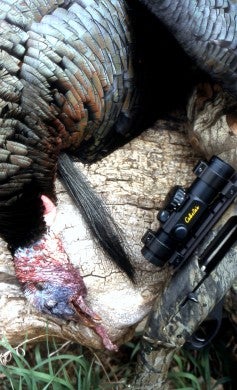Scope Sights for Turkeys
Bob McNally 04.13.15

There’s an old yarn from veteran gobbler hunters that goes something like this: “Anyone who hasn’t missed a turkey, hasn’t shot at many.” It’s an eye-opening truism that cuts right to the bare bone, through all the hype and frivolous baggage that comes with hunting the regal big birds.
And if you want to miss fewer toms, consider putting a telescopic sight atop your favorite shotgun.
“A quality sight designed specifically for turkey hunting is as important to success as a good gun that throws a tight pattern with a custom choke,” says renown Missouri turkey hunter and guide Alex Rutledge, a member of the Hunter Specialties pro hunting team. “The most important thing is to choose a sight you can see well through and one that you have complete confidence in using. And of course, you’ve got to practice with it a good bit.
One of the major benefits of using a telescopic scope on a turkey gun is it’s usually a snap to sight-in with any shotshell load or choke. Patterning a gun is standard practice with most turkey hunters, but sometimes open sights can’t be sufficiently adjusted to bring the sight plane in line with where pellets strike a target. This even can be the case when adjustable iron sights are employed using fiber-optics. Thus, a hunter may be required to “hold” a foot left when a turkey shows or remember to aim a bit “high” or “low” depending on how the gun patterned and its sights could be adjusted. Remembering to aim open sights high or low, left or right of a tom, during heart-pounding moments as a strutting bird approaches, isn’t easy to do–which is why scopes are popular with many hunters.
With a scope, “dialing in” crosshairs to bring the bulk of a pattern perfectly on target is rarely a problem. Another plus for scopes is many designed for turkeys are made “parallax free,” so a hunter need not have his head perfectly positioned on a gun stock behind the optic glass to have it centered on target. This is advantageous should a hunter not be able to move his cheek or head sufficiently under the watchful eyes of a nearby turkey. Just a “side” glance through the scope verifying it’s on target is enough to know the bird’s time has come.
Choosing a style, type, and reticle design for a scope are important considerations. However, many scopes used for deer hunting can be suitable for turkeys, which makes their purchase most economical. The primary consideration for turkeys is that a scope not have too much “power.” Anything over 4X is way too much, and 2X is great for shotgunning birds, with 1X preferred by some hunters. I regularly use variable-power deer scopes on my shotguns, but just dial them down to low power for turkey use, something on the order of 2.5X.
There’s nothing wrong with “pirating” a deer scope off your pet rifle and installing it on your turkey shotgun in the spring. An inexpensive (under $50) “B-Square Shotgun Scope Mount” can be used for many scatterguns to quickly enable them to accommodate an optic. Often just a shotgun receiver pin or two need be replaced for “B-Square” installation (which comes with a “B-Square” mount), and you’re quickly in business for attaching a scope to a shotgun.
I’m a fan of standard duplex crosshairs for scopes and use them for deer, moose, caribou, elk, and other big game. This is why I also prefer them for turkeys. My eyes are tuned to using such sights on big game, and they adjust quickly for toms.
Too many hunters, including expert tom takers, tend to overlook or “economize” on their pet shotgun sight system. Such hunters practice their calling, fine-tune their gun chokes and turkey loads, and go to great lengths scouting birds and outwitting them. But all these things are to no avail if as much care and effort hasn’t gone into choosing and practicing with shotgun sights.
Remember, you can’t hit what you can’t see.
